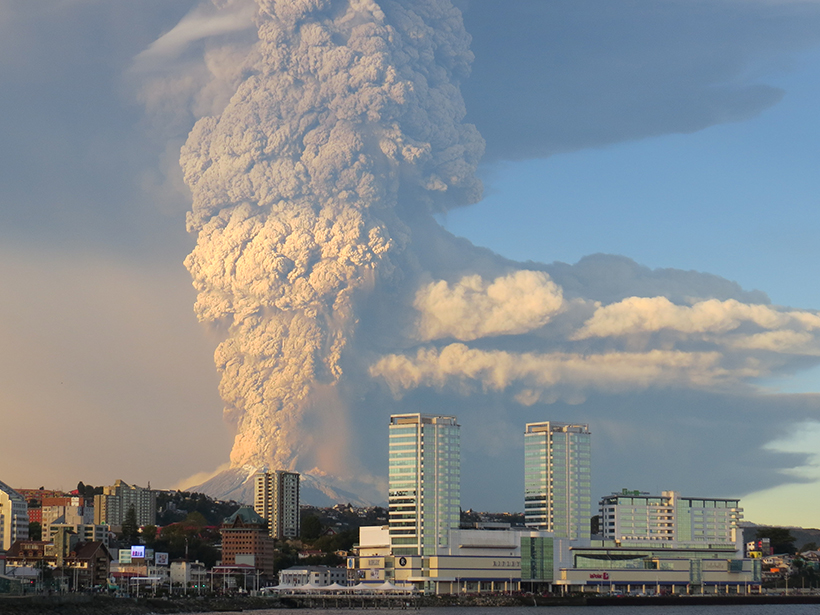To predict and prepare for future climate change, scientists are striving to understand how global-scale climatic change manifests itself on regional scales and also how societies adapt—or don’t—to sometimes subtle and complex climatic changes. In this regard, the strongest volcanic eruptions of the past are powerful test cases, showcasing how the broad climate system responds to sudden changes in radiative forcing and how societies have responded to the resulting climatic shocks.
The strongest volcanic eruptions of the past are powerful test cases, showcasing societies have responded to the resulting climatic shocks.
These issues were at the heart of the inaugural workshop of the Volcanic Impacts on Climate and Society (VICS) Working Group, convened in June 2016 at the Lamont-Doherty Earth Observatory of Columbia University in Palisades, N.Y. The 3-day meeting gathered approximately 50 researchers, who presented work intertwining the history of volcanic eruptions and the physical processes that connect eruptions with human and natural systems on a global scale.
The importance of well-dated and accurate reconstructions of past volcanic activity was a prevalent theme of the workshop. Attendees agreed that sulfate preserved in polar ice cores was the best current record of stratospheric aerosols produced by eruptions over the past 2500 years. Some of the presenters showcased emerging geochemical techniques that enable researchers to identify eruptions with the strongest climatic impact potential: those with high stratospheric sulfate injections.
Other presenters demonstrated how chemical analyses of tephra can connect ice core records to the vast geological record of volcanic eruptions. These developments promise to spur advances in reconstructing the ways that past volcanism drove climatic changes by combining the interpretation of ice core and geologic records with knowledge of physical processes gleaned from observation and modeling of recent eruptions.
Speakers presented evidence of volcanic activity in climate proxies, including tree rings, corals, and glaciers, which provide information on past temperatures and hydroclimate. Presenters discussed how multiproxy analyses combined with historical records can provide holistic multiseasonal understanding of not only the direct radiative effects of eruptions on climate but also changes in ocean and atmosphere circulation following eruptions.
Significant discrepancies, however, remain between the postvolcanic climate anomalies reconstructed from proxies and those simulated by climate models. These discrepancies likely relate to uncertainties in volcanic forcing reconstructions, proxy biases, and model representations of physical processes. Speakers reported on ongoing projects aiming to improve how volcanic eruptions are included in climate models and advance understanding of climatic responses to volcanic forcing through standardized model experiments.
Speakers linked major eruptions to historical famines, mortality, conflict, and state decline.
Improved histories of the timing and magnitude of past volcanic events and better appreciation of the climatic responses to volcanic forcing have also advanced understanding of the connection between volcanism and society. Speakers linked major eruptions to historical famines, mortality, conflict, and state decline. Long volcanic forcing reconstructions combined with written historical records, augmented by archaeological and paleoecological records, allow researchers to examine the varying impact of these volcanic shocks in diverse cultural, technological, and environmental settings.
In sum, the workshop illustrated that closer dialogue among climate scientists, historians, and other scholars of the human past can unlock further synergies. The VICS Working Group plans to foster further multidisciplinary progress through dedicated workshops and collaborative projects.
The VICS workshop was supported by Past Global Changes (PAGES), the Climate Center of the Lamont-Doherty Earth Observatory, the NASA Goddard Institute for Space Studies, and the Yale Climate and History Initiative. The authors thank Kevin Anchukaitis and Michael Sigl for their contributions to this text.
—Matthew Toohey (email: [email protected]), GEOMAR Helmholtz Centre for Ocean Research Kiel, Germany; Francis Ludlow, Trinity College, Dublin, Ireland; and Allegra N. LeGrande, NASA Goddard Institute for Space Studies, New York, N.Y.
Citation:
Toohey, M.,Ludlow, F., and LeGrande, A. N. (2016), How did climate and humans respond to past volcanic eruptions?, Eos, 97, https://doi.org/10.1029/2016EO062599. Published on 10 November 2016.
Text © 2016. The authors. CC BY-NC-ND 3.0
Except where otherwise noted, images are subject to copyright. Any reuse without express permission from the copyright owner is prohibited.

